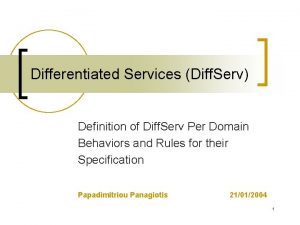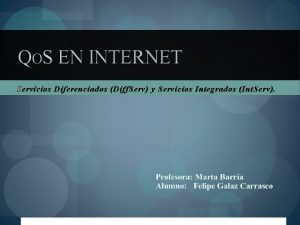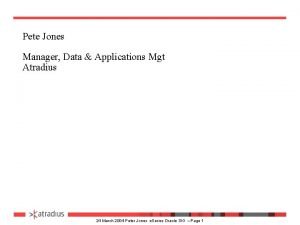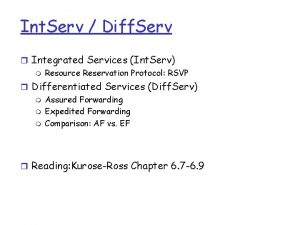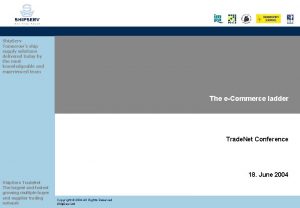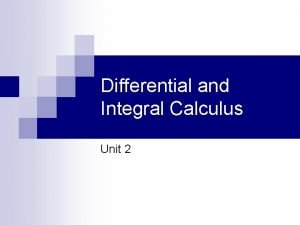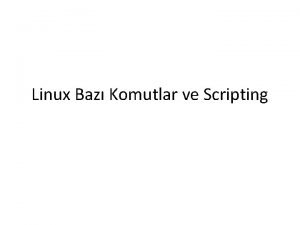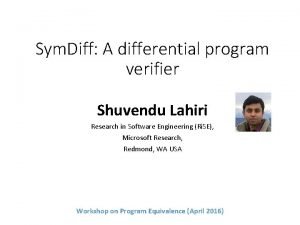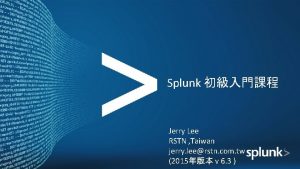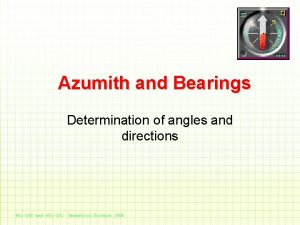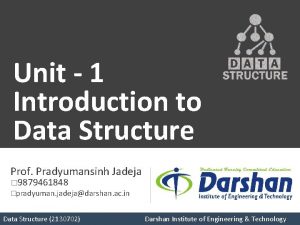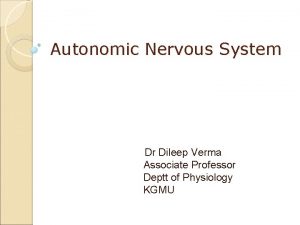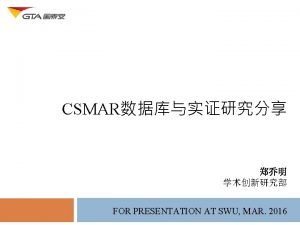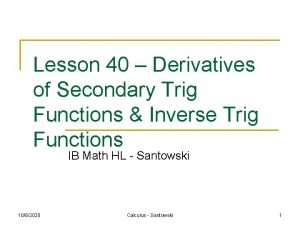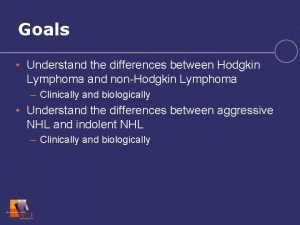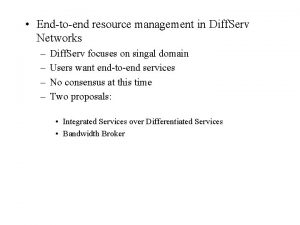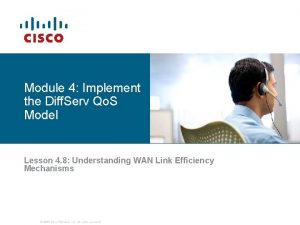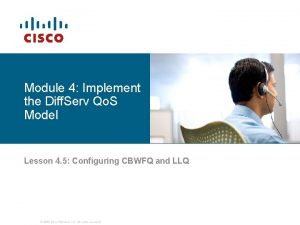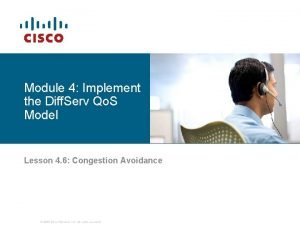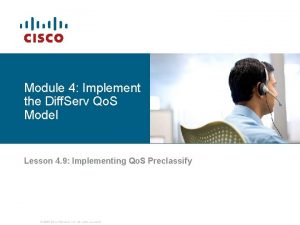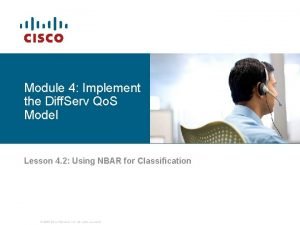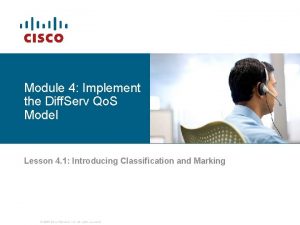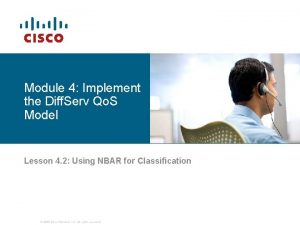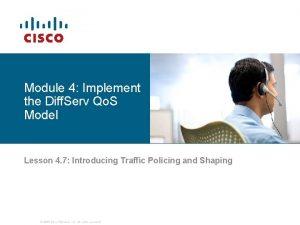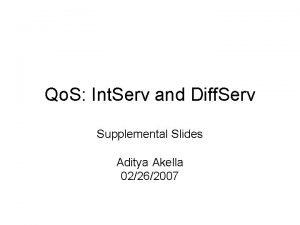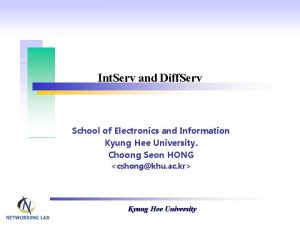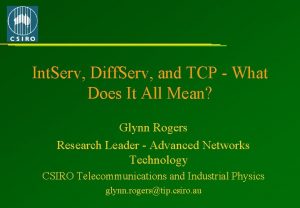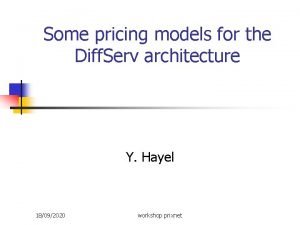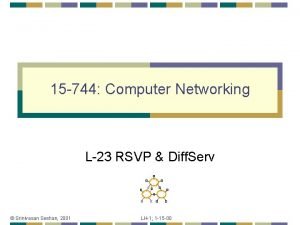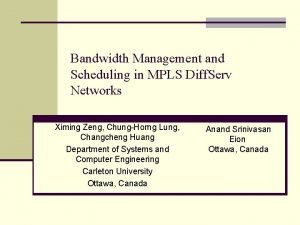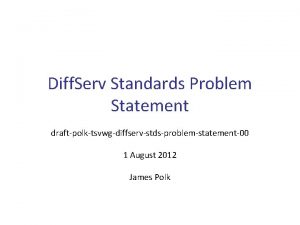Module 4 Implement the Diff Serv Qo S


























- Slides: 26

Module 4: Implement the Diff. Serv Qo. S Model Lesson 4. 6: Congestion Avoidance © 2006 Cisco Systems, Inc. All rights reserved.

Objectives § Describe the limitations of using tail drop to manage interface congestion. § Explain Random Early Detection (RED) and how it is useful in managing interface congestion. § Compare Random Early Detection (RED) with Weighted Random Early Detection (WRED) and Class Based Random Early Detection (CBWRED). § Describe the process of configuring and monitoring CBWRED. © 2006 Cisco Systems, Inc. All rights reserved.

Managing Interface Congestion with Tail Drop § Router interfaces experience congestion when the output queue is full: Additional incoming packets are dropped. Dropped packets may cause significant application performance degradation. Tail drop has significant drawbacks. © 2006 Cisco Systems, Inc. All rights reserved.

Tail Drop Limitations § In some situations, simple tail drop should be avoided because it contains significant flaws: Dropping can affect TCP synchronization. Dropping can cause TCP starvation. There is no differentiated drop—high-priority traffic is dropped as easily as low-priority traffic. © 2006 Cisco Systems, Inc. All rights reserved.

TCP Synchronization § Multiple TCP sessions start at different times. § TCP window sizes are increased. § Tail drops cause many packets of many sessions to be dropped at the same time. § TCP sessions restart at the same time (synchronized). © 2006 Cisco Systems, Inc. All rights reserved.

TCP Delay, Jitter, and Starvation § Constant high buffer usage (long queue) causes delay. § Variable buffer usage causes jitter. § More aggressive flows can cause other flows to starve. § No differentiated dropping occurs. © 2006 Cisco Systems, Inc. All rights reserved.

Random Early Detection (RED) § Tail drop can be avoided if congestion is prevented. § RED is a mechanism that randomly drops packets before a queue is full. § RED increases drop rate as the average queue size increases. § RED result: TCP sessions slow to the approximate rate of output-link bandwidth. Average queue size is small (much less than the maximum queue size). TCP sessions are desynchronized by random drops. © 2006 Cisco Systems, Inc. All rights reserved.

RED Drop Profiles © 2006 Cisco Systems, Inc. All rights reserved.

RED Modes § RED has three modes: No drop: When the average queue size is between 0 and the minimum threshold Random drop: When the average queue size is between the minimum and the maximum threshold Full drop (tail drop): When the average queue size is above the maximum threshold § Random drop should prevent congestion (prevent tail drops). © 2006 Cisco Systems, Inc. All rights reserved.

TCP Traffic Before and After RED © 2006 Cisco Systems, Inc. All rights reserved.

Weighted Random Early Detection (WRED) § WRED can use multiple RED profiles. § Each profile is identified by: Minimum threshold Maximum threshold Mark probability denominator § WRED profile selection is based on: IP precedence (8 profiles) DSCP (64 profiles) § WRED drops less important packets more aggressively than more important packets. § WRED can be applied at the interface, VC, or class level. © 2006 Cisco Systems, Inc. All rights reserved.

WRED Building Blocks © 2006 Cisco Systems, Inc. All rights reserved.

Class-Based WRED (CBWRED) § Class-based WRED is available when configured in combination with CBWFQ. § Using CBWFQ with WRED allows the implementation of Diff. Serv Assured Forwarding PHB. § Class-based configuration of WRED is identical to stand -alone WRED. © 2006 Cisco Systems, Inc. All rights reserved.

DSCP-Based WRED (Expedited Forwarding) © 2006 Cisco Systems, Inc. All rights reserved.

Configuring CBWRED router(config-pmap-c)# random-detect • Enables IP precedence-based WRED in the selected class within the service policy configuration mode. • Default service profile is used. • Command can be used at the interface, per. VC (with random-detect-group), or at the class level (service policy). • Precedence-based WRED is the default mode. • WRED treats non-IP traffic as precedence 0. policy-map Policy 1 class mission-critical bandwidth percent 30 random-detect class transactional bandwidth percent 20 random-detect class-default fair-queue random-detect © 2006 Cisco Systems, Inc. All rights reserved.

Changing the WRED Traffic Profile router(config-pmap-c)# random-detect precedence min-threshold max-threshold mark-prob-denominator § Changes WRED profile for specified IP precedence value. § Packet drop probability at maximum threshold is: 1 / mark-prob-denominator § Nonweighted RED is achieved by using the same WRED profile for all precedence values. © 2006 Cisco Systems, Inc. All rights reserved.

CBWFQ Using IP Precedence with CBWRED § Enable CBWFQ to prioritize traffic according to the following requirements: Class mission-critical is marked with IP precedence values 3 and 4 (3 is high drop, 4 is low drop) and should get 30% of interface bandwidth. Class bulk is marked with IP precedence values 1 and 2 (1 is high drop, 2 is low drop) and should get 20% of interface bandwidth. All other traffic should be per-flow fair-queued. § Use differentiated WRED to prevent congestion in all three classes. © 2006 Cisco Systems, Inc. All rights reserved.

Sample WRED Traffic Profile with CBWRED © 2006 Cisco Systems, Inc. All rights reserved.

WRED Profiles: DSCP-Based WRED (Assured Forwarding) © 2006 Cisco Systems, Inc. All rights reserved.

Configuring DSCP-Based CBWRED router(config-pmap-c)# random-detect dscp-based § Enables DSCP-based WRED. § Command can be used at the interface, per. VC (with random detect group), or at the class level (service policy). § Default service profile is used. § The WRED random-detect command the WFQ queue-limit command are mutually exclusive for class policy. © 2006 Cisco Systems, Inc. All rights reserved.

Changing the WRED Traffic Profile router(config-pmap-c)# random-detect dscpvalue min-threshold max-threshold markprob-denominator • Changes WRED profile for specified DSCP value • Packet drop probability at maximum threshold is: 1 / mark-prob-denominator © 2006 Cisco Systems, Inc. All rights reserved.

CBWRED Using DSCP: Example § Enable CBWFQ to prioritize traffic according to the following requirements: Class mission-critical is marked using DSCP AF 2 and should get 30% of interface bandwidth. Class bulk is marked using DSCP AF 1 and should get 20% of interface bandwidth. All other traffic should be per-flow fair-queued. § Use differentiated WRED to prevent congestion in all three classes. § Make sure that the new configurations still conform to the design and implementation from the previous example. © 2006 Cisco Systems, Inc. All rights reserved.

CBWRED Using DSCP: Example (Cont. ) © 2006 Cisco Systems, Inc. All rights reserved.

Monitoring CBWRED router# show policy-map interface-name • Displays the configuration of all classes configured for all service policies on the specified interface router#show policy-map interface Ethernet 0/0 Service-policy output: Policy 1 Class-map: Mission-critical (match-all) 0 packets, 0 bytes 5 minute offered rate 0 bps, drop rate 0 bps Match: ip precedence 2 Match: ip dscp 18 20 22 Weighted Fair Queueing Output Queue: Conversation 265 Bandwidth 30 (%) Bandwidth 3000 (kbps) (pkts matched/bytes matched) 0/0 (depth/total drops/no-buffer drops) 0/0/0 exponential weight: 9 mean queue depth: 0 Dscp Transmitted Random drop Tail drop Minimum Maximum Mark (Prec) pkts/bytes threshold probability 0(0) 0/0 0/0 20 40 1/10 1 0/0 0/0 22 40 1/10 2 0/0 0/0 24 40 1/10 © 2006 Cisco Systems, Inc. All rights reserved.

Self Check 1. What is TCP global synchronization? 2. Why is global synchronization a problem? 3. What are the 3 drop modes of RED? 4. What IP precedence value does WRED assume for non-IP traffic? 5. What is the mark probability denominator? © 2006 Cisco Systems, Inc. All rights reserved.

Summary § Tail drop is the default queuing response to congestion. Tail drop treats all traffic equally and does not differentiate among classes of service. Tail drop can cause issues such as global synchronization or starvation. § Random Early Detection (RED) and Weighted Random Early Detection (WRED) are more sophisticated methods of avoiding congestion and the issues associated with tail drop. § Random early detection (RED) is a dropping mechanism that randomly drops packets before a queue is full, thus helping to avoid tail drop. § Weighted random early detection (WRED) combines RED with IP precedence or DSCP and performs packet dropping based on IP precedence or DSCP markings. © 2006 Cisco Systems, Inc. All rights reserved.
 Diff serv
Diff serv Que son los servicios diferenciados
Que son los servicios diferenciados Diff in diff regression
Diff in diff regression Atradius serv net
Atradius serv net Apa serv alexandria
Apa serv alexandria Int serv
Int serv Exploit
Exploit Global trade repository
Global trade repository Ship serv
Ship serv Rekeszizom sérv
Rekeszizom sérv C device module module 1
C device module module 1 Meaning of bc and ad
Meaning of bc and ad Limit power rule
Limit power rule Shell script diff
Shell script diff Six errors of trial balance
Six errors of trial balance First principle of differentiation
First principle of differentiation Shuvendu lahiri
Shuvendu lahiri Schottky and frenkel defects
Schottky and frenkel defects Splunk boss
Splunk boss Azumith
Azumith Unit 1 introduction
Unit 1 introduction Chain and compass survey
Chain and compass survey Diff between sympathetic and parasympathetic
Diff between sympathetic and parasympathetic Avg diff
Avg diff Diff between measles and chickenpox
Diff between measles and chickenpox Sin^-1 derivative
Sin^-1 derivative Difference between hodgkin and non hodgkin lymphoma
Difference between hodgkin and non hodgkin lymphoma
